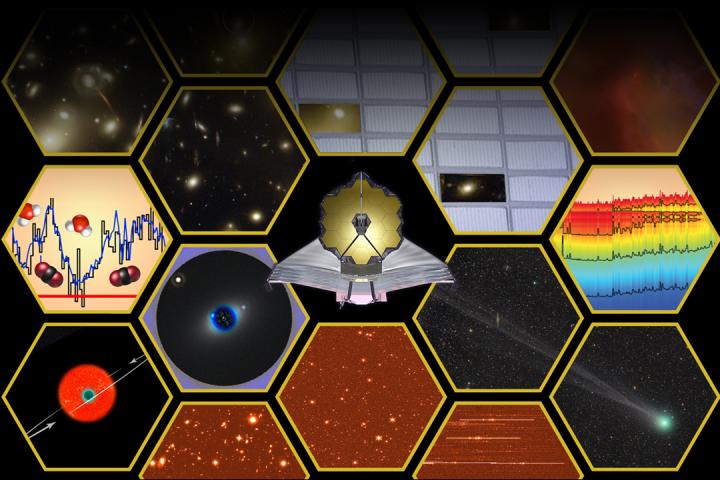
Credit: Credits: NASA, ESA, and A. Feild (STScI)
When the James Webb Space Telescope, despite repeated delays, finally launches in October, and after some initial calibrations begins its first cycle of observations, these will include an impressive Danish participation. Cosmic Dawn Center – a collaboration between Technical University of Denmark and the Niels Bohr Institute, University of Copenhagen – will be at work from the very beginning. The primary focus will be on learning more about the Universe’s earliest galaxies.
With a diameter almost three times that of the Hubble Space Telescope, the James Webb Space Telescope will be the largest ever launched into space. It is also being hailed as Hubble’s successor. James Webb is built primarily to observe infrared light and will therefore revolutionise our knowledge of the very early Universe in particular — the reason is that, the longer light has travelled through the Universe, the longer its wavelength becomes, and thus also the more (infra)red it becomes.
At the Niels Bohr Institute and DTU Space’s basic research centre “Cosmic Dawn Center” (or DAWN), which conducts research into galaxies, they are particularly excited about the launch of James Webb: the Danish researchers will participate in 2133 hours of the first cycle’s 6000 assigned hours of observation time, or over ? of the total time available.
The DAWN centre has a special stake in James Webb, having contributed to the construction of two of the telescope’s instruments. As a reward, they have been assigned a number of “extra” observation hours. However, the other over 2000 hours have been achieved in equal competition with researchers from 40 other countries.
The earliest galaxies
The overall goal of DAWN’s programme is to study the earliest, and therefore most distant, galaxies in the Universe.
The most ambitious observational program has been dubbed “COSMOS-Webb”. This programme intends to survey a large part of the already well-visited region of the sky that Hubble has long held in its spotlight. And the expected results will be magnificent: half a million galaxies, many from the period when the Universe was at a mere 5% of its current age.
The telescope’s giant mirror allows it to gather large amounts of light; crucial for observing the extremely faint objects in question. But just as a camera deploys a longer shutter speed to capture pictures at twilight, James Webb will also take very long exposures: an impressive 208 hours will be spent creating the deepest panoramic image to date of an unsurpassed population of the earliest galaxies.
“It’s unique that such a large and ambitious program is being implemented from the very beginning of James Webb’s guaranteed life span, which is just 5 years. This gives us, and all other users of the space telescope, the chance to identify thousands of galaxies of all types and at all evolutionary stages in the earliest Universe, including the rarest ones, which can be studied in detail through James Webb in the coming years,” explains Georgios Magdis, associate professor in astronomy at the Cosmic Dawn Center.
Sune Toft, professor and DAWN’s Center Director, who like Georgios Magdis is participating in the COSMOS-Webb collaboration, elaborates: “In addition to the galaxies we expect to find, we’re convinced that the most exciting discoveries that a large survey like this will uncover, are ones we aren’t even yet able to imagine. That’s what the history of astronomy has constantly demonstrated”.
…and the largest
While COSMOS-Webb is the largest programme, DAWN is also involved in several other programmes, some led by early career researchers at the center. Instead of looking “broadly” at thousands of galaxies, one of these programmes has chosen to focus on five already well-known galaxies; not just random ones, but five galaxies so large and evolved that they challenge our understanding of galaxy formation.
“We will peer back in time to capture the light of these mysterious galaxies, tracing out their stars, gas, and dust inside and out”, explains John Weaver, PhD student at DAWN and leader of this project.
James Webb sees double
For yet another one of the selected programmes, James Webb is simply not enough. DAWN’s postdoc Seiji Fujimoto, who is leading this third programme, will employ a marvellous technique, where gravity itself can deflect and enlarge the image of a galaxy, 28 billion light-years away.
Not only is the light amplified some 100 times; the magnification also allows him to study the galaxy’s inner structure to an unprecedented degree. Moreover, because light can take different paths through space, the galaxy can be observed in several multiple places in the sky at the same time.
These observations are not only interesting in themselves, but also increase expectations for future research. “When next-generation telescopes in the 30-metre class are ready, we will be able to study star clusters, and perhaps even individual stars, in the most distant galaxies”, affirms Seiji Fujimoto.
###
Media Contact
Peter Laursen
[email protected]
Original Source
https:/




